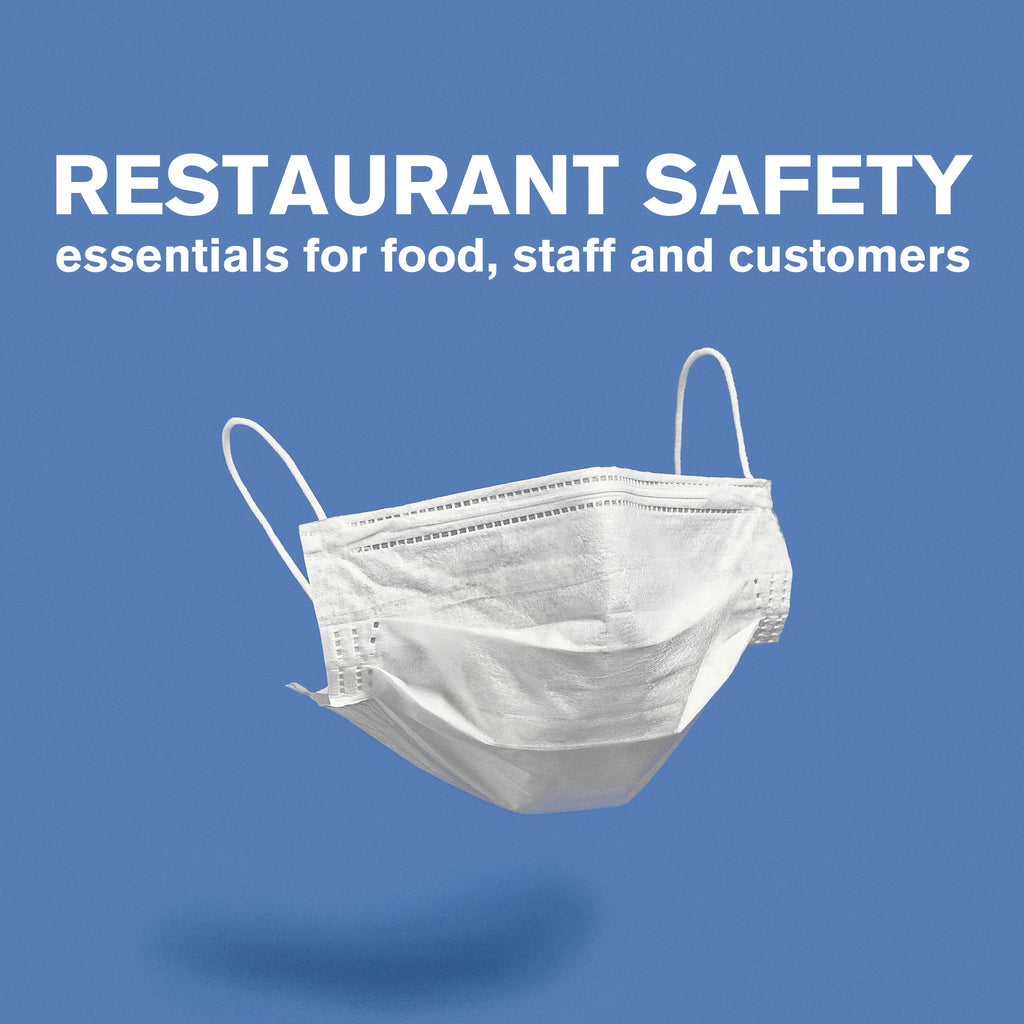Restaurant Safety Essentials for Food, Staff and Customers
Posted by JENNIFER TUMILTY

Restaurant Safety Essentials for Food, Staff and Customers
Prepared with a plan is key to the health and safety of food service businesses. An effective plan starts with understanding the rules and regulations. These guidelines about food safety, protecting staff and customers and safeguarding your commercial kitchen are available from local authorities.
A plan, whether digital or on paper, is a great start but executing the plan requires the right tools and supplies close at hand to defend against hazards.

Food Safety
A safe food handling certificate is only the beginning of a food safety plan for your operation. Paired with the correct tools is a recipe for success.Food Handling – The proper handling of food is the only way to reduce the risk of spreading food borne illnesses. Paying attention and following the plan will significantly decrease the chances of cross contamination. But to do that, the right supplies should be within easy reach.
Colour coded cutting boards dedicated to food types is a simple and visible solution. Cooking foods to proper temperatures is imperative and the only way to accurately measure temperature is using a thermometer.

Food Storage - Controlling temperature, time, location and packaging are important to keeping food safe during storage. The temperature of fridges, freezers, cold tables and hot tables can only be monitored with a thermometer. Ensure to match the thermometer with the task.
Every food item has an expiry time and date. It goes beyond the helpful saying of ‘keep hot foods hot and cold food cold’. Yes, it’s important to avoid the danger zone and to limit the holding time of prepared foods but the quality (and safety) of your prepared foods starts with the proper storage of ingredients.
A pen and paper, or digitally if preferred, is the easiest way to keep track. A kitchen timer doesn’t hurt either.
Location for storing ingredients and prepared foods is more than just knowing fridge, freezer or dry storage. It’s also important to know if your ingredients and prepared food belong on shelves off the floor, the proper location of raw meats versus vegetables in your fridge and practicing FIFO (first in first out) inventory management.
Ingredients and finished dishes need proper packaging to stay safe. Strong and durable food grade packaging and containers, lids that fit to reduce spilling but also reduce the risk of cross contamination. Labelling is also a big part of proper packaging, you can't store it right if you don't know what it is or when it was prepared.
Cleaning and Sanitizing – Proper cleaning and sanitizing of food prep tools and kitchen equipment can’t happen without the appropriate supplies and tools. Yes, that means having the correct cleaning products available but it’s more than that.
Brushes of various shapes, sizes and styles are needed to get into the hard-to-reach places that bacteria like to reside in- like cutting boards, pipes and tight corners.
Buckets (small, large or colour coded) offers a quick guide for cleaning and sanitizing in all kitchen areas. Thermometers to test water temperature of dishwashers and for manual dishwashing, test strips to ensure the correct dilution of your sanitizing solution all play an important role.
Staff Safety
Safety training is the most essential tool to protect your staff - from physical hazards but also from the harder to see ones. To effectively apply the training the proper gear is needed.
- Mats, slip-resistant and anti-fatigue
- Aprons
- Cutting board grip mats
- Cut resistant gloves
- Heat resistant gloves
- Disposable gloves
- Wet floor signs
- Masks
- Face shields
In the Kitchen – Commercial kitchens can be hazardous places to work. A few simple and highly effective items can significantly cut down the risks.
Slip resistant mats at workstations, while masks or goggles and aprons protect from spills and chemicals.
Grip mats for cutting boards for a stable cutting surface. Remember to protect hands - cut resistant gloves, heat resistant gloves for the oven, rotisserie or fryer and disposable gloves. And remember first aid kits in all major work areas.

In the Dining/Delivery Area – The hazards don’t stop when staff leave the kitchen. Workstations need slip-resistant and anti-fatigue mats and wet floor signs to bring attention to caution areas.
Personal - Washing hands properly is integral to commercial kitchen safety, not to mention community safety. Now, it’s necessary to protect staff further by providing disposable gloves, face masks and face shields.
Customer Safety
More than ever before, your customers need to feel safe and secure. Communicate online and onsite with your customers so they know you care about their safety. Be ready with the right supplies to ease their minds.
- Hand sanitizer
- Hands-free door pulls
- Hands-free soap and paper towel dispensers
- Floor tape
- Floor and table markers
Hand sanitizers and disposable masks are a must have at all times. Stock up and place generously throughout your space so customers don't need to search (or ask).
Reducing the amount of surface touching can also ease customers minds and reduce the number of contact surfaces. Hands free pushers and pulls for doors, automatic soap and paper towel dispensers and even tapping/prepayment of orders all can help minimize surface touching.

Knowing where to go or where not to go can help with social distancing to keep both staff and customers a safe. Using floor tapes, floor markers and table markers, customers can quickly see the plan.
Your foodservice business - restaurant kitchen, dining room, take out window and washrooms - require safety tools and supplies. Using these essentials along with your plan will keep your food, staff and customers safe.

